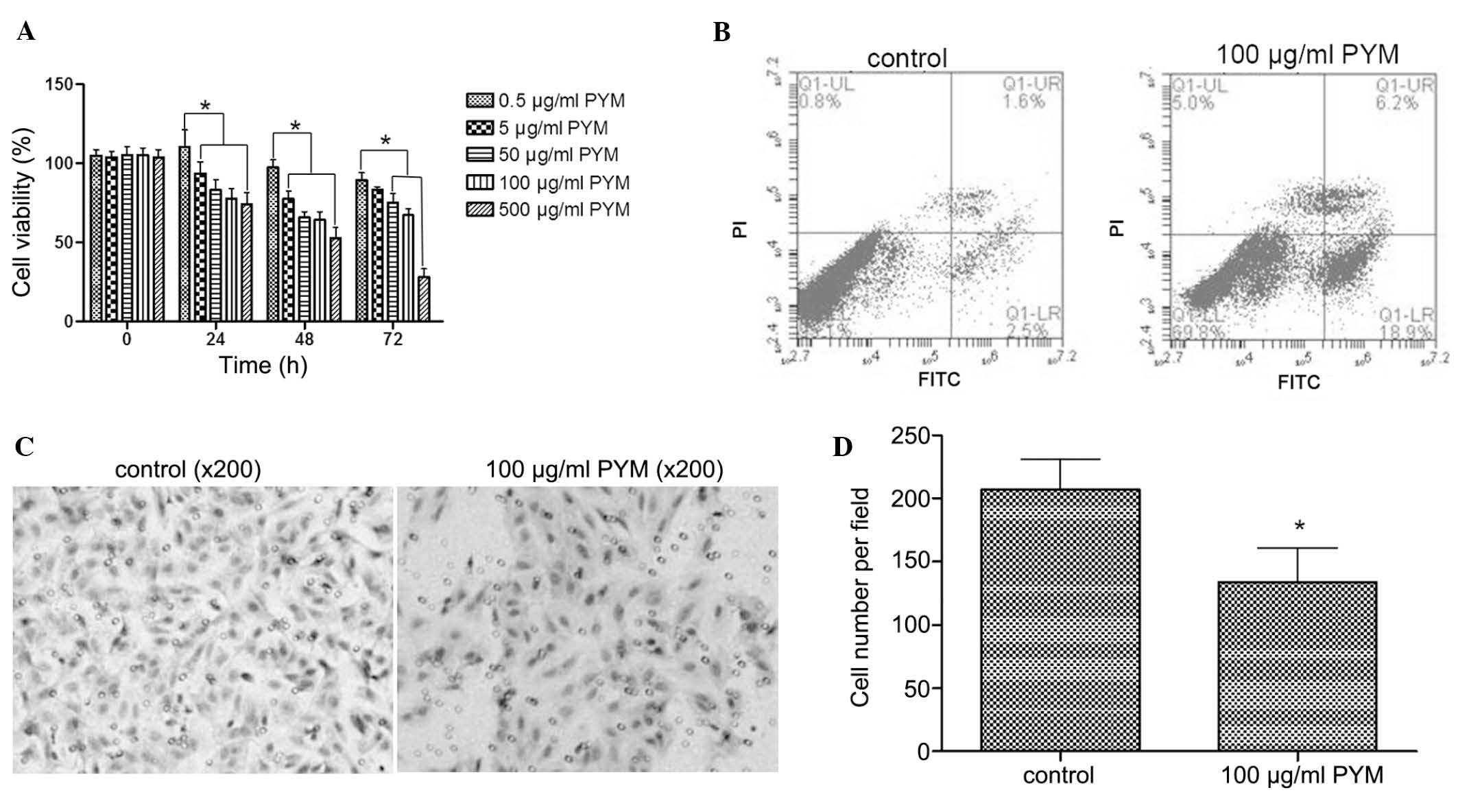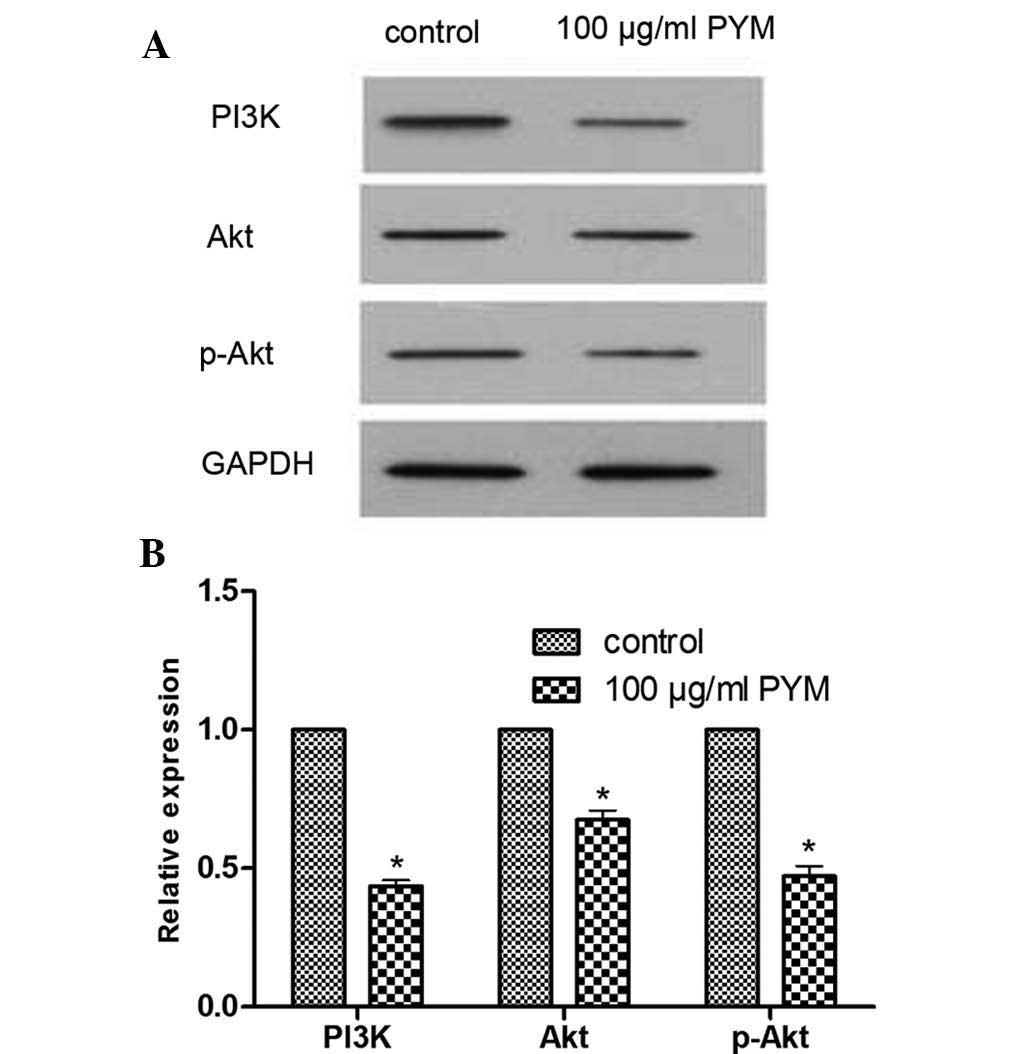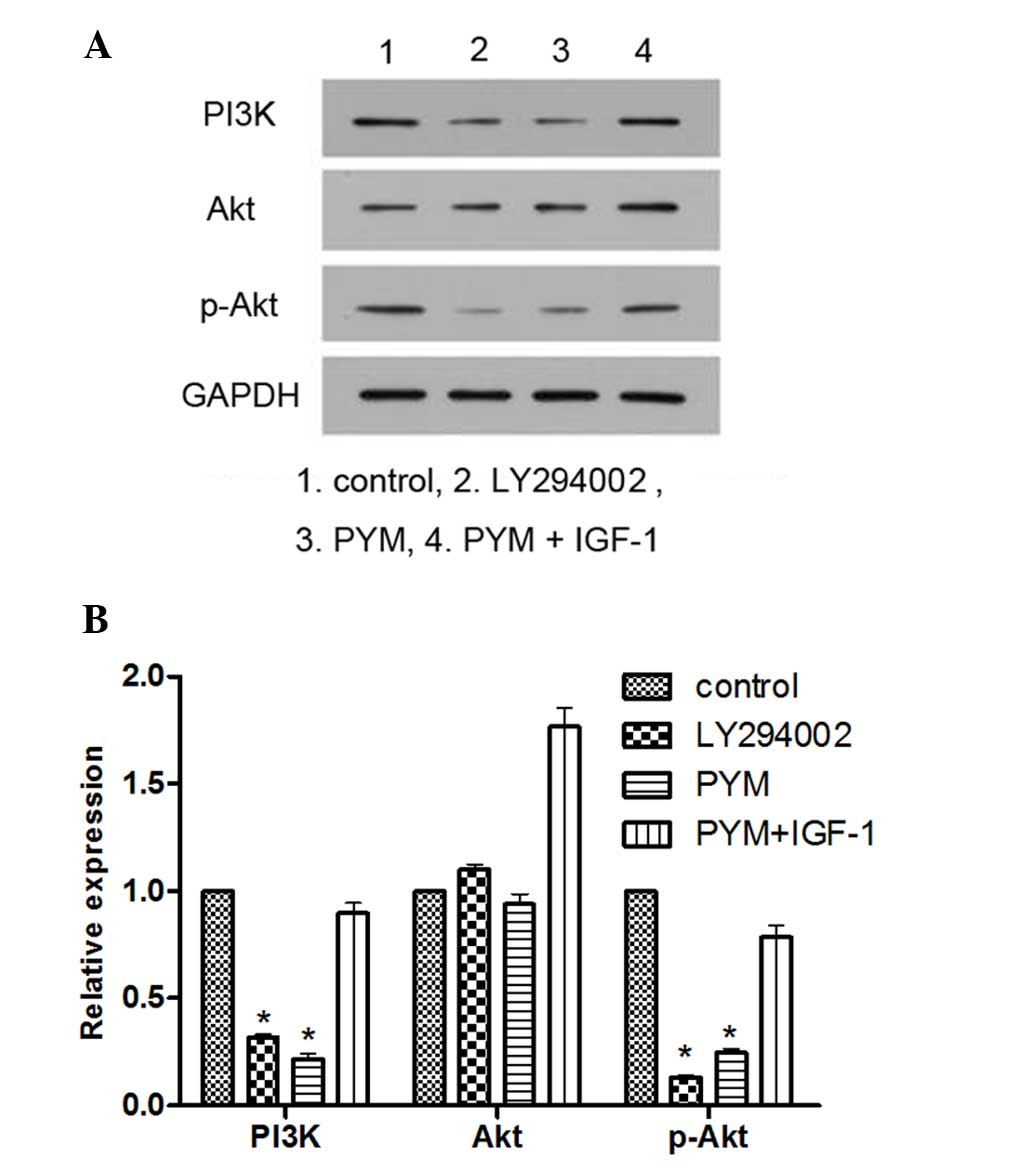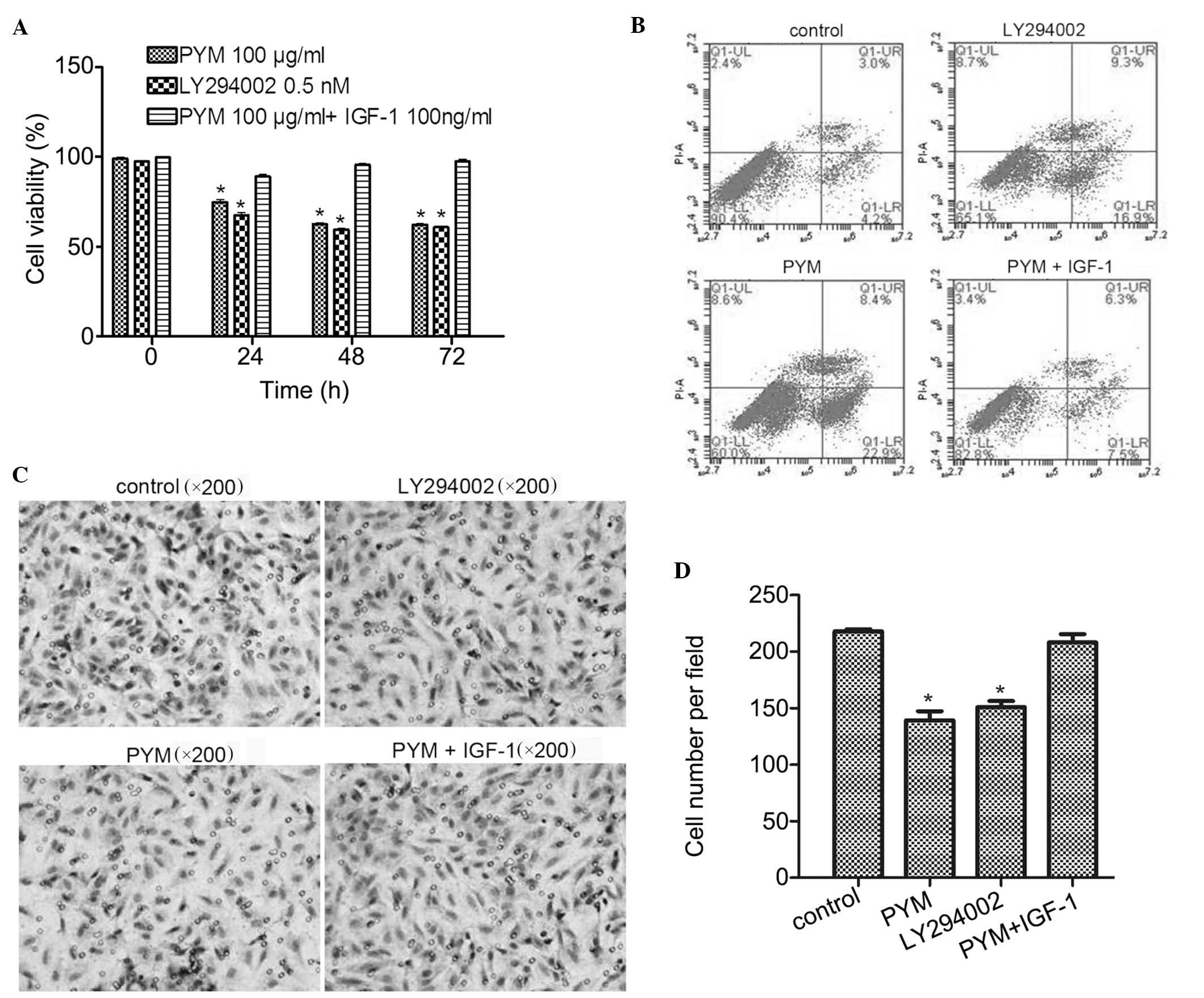|
1
|
Meisheng X: Histopathologic study of
esophageal squamous cell carcinoma treated preoperatively with
Pingyangmycin. Chin Med J (Engl). 92:343–348. 1979.
|
|
2
|
Zheng JW, Zhou Q, Yang XJ, He Y, Wang YA,
Ye WM, Zhu HG and Zhang ZY: Intralesional injection of
Pingyangmycin may be an effective treatment for epulis. Med
Hypotheses. 72:453–454. 2009. View Article : Google Scholar : PubMed/NCBI
|
|
3
|
Liang XH, He YW, Tang YL, Wu JL, Cao XP,
Xiao GZ and Mao ZY: Thermochemotherapy of lower lip squamous cell
carcinoma without metastases: An experience of 31 cases. J
Craniomaxillofac Surg. 38:260–265. 2010. View Article : Google Scholar
|
|
4
|
Guan JY, He XF, Chen Y, Zeng QL, Mei QL
and Li YH: Percutaneous intratumoral injection with pingyangmycin
lipiodol emulsion for the treatment of recurrent sacrococcygeal
chordomas. J Vasc Interv Radiol. 22:1216–1220. 2011. View Article : Google Scholar : PubMed/NCBI
|
|
5
|
Qi W, Guo J, Wu S, Su B, Zhang L, Pan J
and Zhang J: Synergistic effect of nanosecond pulsed electric field
combined with low-dose of pingyangmycin on salivary adenoid cystic
carcinoma. Oncol Rep. 31:2220–2228. 2014.PubMed/NCBI
|
|
6
|
Bai N, Chen YZ, Fu YJ, Wu P and Zhang WN:
A clinical study of pingyangmycin sclerotherapy for venous
malformation: An evaluation of 281 consecutive patients. J Clin
Pharm Ther. 39:521–526. 2014. View Article : Google Scholar : PubMed/NCBI
|
|
7
|
Jia R, Xu S, Huang X, Song X, Pan H, Zhang
L, He F, Lin M, Ge S and Fan X: Pingyangmycin as first-line
treatment for low-flow orbital or periorbital venous malformations:
Evaluation of 33 consecutive patients. JAMA Ophthalmol.
132:942–948. 2014. View Article : Google Scholar : PubMed/NCBI
|
|
8
|
Yue H, Qian J, Elner VM, Guo J, Yuan YF,
Zhang R and Ge Q: Treatment of orbital vascular malformations with
intralesional injection of pingyangmycin. Br J Ophthalmol.
97:739–745. 2013. View Article : Google Scholar : PubMed/NCBI
|
|
9
|
Luo QF and Zhao FY: The effects of
Bleomycin A5 on infantile maxillofacial haemangioma. Head Face Med.
7:112011. View Article : Google Scholar : PubMed/NCBI
|
|
10
|
Luo Q and Zhao F: How to use bleomycin A5
for infantile maxillofacial haemangiomas: Clinical evaluation of 82
consecutive cases. J Craniomaxillofac Surg. 39:482–486. 2011.
View Article : Google Scholar
|
|
11
|
Hou J, Wang M, Tang H, Wang Y and Huang H:
Pingyangmycin sclerotherapy for infantile hemangiomas in oral and
maxillofacial regions: An evaluation of 66 consecutive patients.
Int J Oral Maxillofac Surg. 40:1246–1251. 2011. View Article : Google Scholar : PubMed/NCBI
|
|
12
|
Yang Y, Sun M, Cheng X, Hu X, Zhang P, Ma
Q, Li J, Tian L and Lei D: Bleomycin A5 plus dexamethasone for
control of growth in infantile parotid hemangiomas. Oral Surg Oral
Med Oral Pathol Oral Radiol Endod. 108:62–69. 2009. View Article : Google Scholar : PubMed/NCBI
|
|
13
|
Zheng JW, Zhou Q, Yang XJ, Wang YA, Fan
XD, Zhou GY, Zhang ZY and Suen JY: Treatment guideline for
hemangiomas and vascular malformations of the head and neck. Head
Neck. 32:1088–1098. 2010. View Article : Google Scholar
|
|
14
|
Greenberger S and Bischoff J: Infantile
hemangioma-mechanism(s) of drug action on a vascular tumor. Cold
Spring Harb Perspect Med. 1:a0064602011. View Article : Google Scholar
|
|
15
|
Greenberger S and Bischoff J: Pathogenesis
of infantile haemangioma. Br J Dermatol. 169:12–19. 2013.
View Article : Google Scholar : PubMed/NCBI
|
|
16
|
Verheul HM and Pinedo HM: The role of
vascular endothelial growth factor (VEGF) in tumor angiogenesis and
early clinical development of VEGF-receptor kinase inhibitors. Clin
Breast Cancer. 1(Suppl 1): S80–S84. 2000. View Article : Google Scholar
|
|
17
|
Boye E and Olsen BR: Signaling mechanisms
in infantile hemangioma. Curr Opin Hematol. 16:202–208. 2009.
View Article : Google Scholar : PubMed/NCBI
|
|
18
|
Augustin HG, Koh GY, Thurston G and
Alitalo K: Control of vascular morphogenesis and homeostasis
through the angiopoietin-Tie system. Nat Rev Mol Cell Biol.
10:165–177. 2009. View
Article : Google Scholar : PubMed/NCBI
|
|
19
|
Phng LK and Gerhardt H: Angiogenesis: A
team effort coordinated by notch. Dev Cell. 16:196–208. 2009.
View Article : Google Scholar : PubMed/NCBI
|
|
20
|
Bauer TM, Patel MR and Infante JR:
Targeting PI3 kinase in cancer. Pharmacol Ther. 146:53–60. 2015.
View Article : Google Scholar
|
|
21
|
Phung TL, Eyiah-Mensah G, O'Donnell RK,
Bieniek R, Shechter S, Walsh K, Kuperwasser C and Benjamin LE:
Endothelial Akt signaling is rate-limiting for rapamycin inhibition
of mouse mammary tumor progression. Cancer Res. 67:5070–5075. 2007.
View Article : Google Scholar : PubMed/NCBI
|
|
22
|
Guba M, von Breitenbuch P, Steinbauer M,
Koehl G, Flegel S, Hornung M, Bruns CJ, Zuelke C, Farkas S,
Anthuber M, et al: Rapamycin inhibits primary and metastatic tumor
growth by antiangiogenesis: Involvement of vascular endothelial
growth factor. Nat Med. 8:128–135. 2002. View Article : Google Scholar : PubMed/NCBI
|
|
23
|
Tai KW, Chang YC, Chou LS and Chou MY:
Cytotoxic effect of pingyangmycin on cultured KB cells. Oral Oncol.
34:219–223. 1998. View Article : Google Scholar : PubMed/NCBI
|
|
24
|
Tu JB, Li QY, Jiang F, Hu XY, Ma RZ, Dong
Q, Zhang H, Pattar P and Li SX: Pingyangmycin stimulates apoptosis
in human hemangioma-derived endothelial cells through activation of
the p53 pathway. Mol Med Rep. 10:301–305. 2014.PubMed/NCBI
|
|
25
|
Zhao J, Wang SZ, Tang XF, Liu N, Zhao D
and Mao ZY: Analysis of thermochemotherapy-induced apoptosis and
the protein expressions of Bcl-2 and Bax in maxillofacial squamous
cell carcinomas. Med Oncol. 28(Suppl 1): S354–S359. 2011.
View Article : Google Scholar
|
|
26
|
Huang Y, Li P, Xia S, Zhuo Y and Wu L:
Proapoptotic effect and the mechanism of action of pingyangmycin on
cavernous hemangiomas. Exp Ther Med. 7:473–477. 2014.PubMed/NCBI
|
|
27
|
Tai KW, Chou MY, Hu CC, Yang JJ and Chang
YC: Induction of apoptosis in KB cells by pingyangmycin. Oral
Oncol. 36:242–247. 2000. View Article : Google Scholar : PubMed/NCBI
|
|
28
|
Yang LC, Yang SH, Tai KW, Chou MY and Yang
JJ: MEK inhibition enhances bleomycin A5-induced apoptosis in an
oral cancer cell line: Signaling mechanisms and therapeutic
opportunities. J Oral Pathol Med. 33:37–45. 2004. View Article : Google Scholar
|
|
29
|
Fruman DA and Rommel C: PI3K and cancer:
Lessons, challenges and opportunities. Nat Rev Drug Discov.
13:140–156. 2014. View
Article : Google Scholar : PubMed/NCBI
|
|
30
|
Hassan B, Akcakanat A, Holder AM and
Meric-Bernstam F: Targeting the PI3-kinase/Akt/mTOR signaling
pathway. Surg Oncol Clin N Am. 22:641–664. 2013. View Article : Google Scholar : PubMed/NCBI
|
|
31
|
Khan KH, Yap TA, Yan L and Cunningham D:
Targeting the PI3K-AKT-mTOR signaling network in cancer. Chin J
Cancer. 32:253–265. 2013. View Article : Google Scholar : PubMed/NCBI
|
|
32
|
Sun SY: MTOR kinase inhibitors as
potential cancer therapeutic drugs. Cancer Lett. 340:1–8. 2013.
View Article : Google Scholar : PubMed/NCBI
|
|
33
|
Alessi DR, Pearce LR and Garcia-Martinez
JM: New insights into mTOR signaling: MTORC2 and beyond. Sci
Signal. 2:pe272009. View Article : Google Scholar : PubMed/NCBI
|
|
34
|
Zheng NN, Ding XD and Zhang HP: Targeting
rictor inhibits mouse vascular tumor cell proliferation and
invasion in vitro and tumor growth in vivo. Neoplasma. 60:41–45.
2013. View Article : Google Scholar
|
|
35
|
Aouida M and Ramotar D: A new twist in
cellular resistance to the anticancer drug bleomycin-A5. Curr Drug
Metab. 11:595–602. 2010. View Article : Google Scholar : PubMed/NCBI
|
|
36
|
Raisfeld IH: Pulmonary toxicity of
bleomycin analogs. Toxicol Appl Pharmacol. 56:326–336. 1980.
View Article : Google Scholar : PubMed/NCBI
|
|
37
|
Russo RC, Garcia CC, Barcelos LS, Rachid
MA, Guabiraba R, Roffê E, Souza AL, Sousa LP, Mirolo M, Doni A, et
al: Phosphoinositide 3-kinase γ plays a critical role in
bleomycin-induced pulmonary inflammation and fibrosis in mice. J
Leukoc Biol. 89:269–282. 2011. View Article : Google Scholar
|
|
38
|
Wei X, Han J, Chen ZZ, Qi BW, Wang GC, Ma
YH, Zheng H, Luo YF, Wei YQ and Chen LJ: A phosphoinositide
3-kinase-gamma inhibitor, AS605240 prevents bleomycin-induced
pulmonary fibrosis in rats. Biochem Biophys Res Commun.
397:311–317. 2010. View Article : Google Scholar : PubMed/NCBI
|













